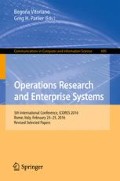Abstract
In this paper, we formulate the random bimatrix game as a chance-constrained game using chance constraint. We show that a Nash equilibrium problem, corresponding to independent normally distributed payoffs, is equivalent to a nonlinear complementarity problem. Further if the payoffs are also identically distributed, a strategy pair where each player’s strategy is the uniform distribution over his action set, is a Nash equilibrium. We show that a Nash equilibrium problem corresponding to independent Cauchy distributed payoffs, is equivalent to a linear complementarity problem.
Access this chapter
Tax calculation will be finalised at checkout
Purchases are for personal use only
References
Bazaraa, M., Sherali, H., Shetty, C.: Nonlinear Programming Theory and Algorithms, 3rd edn. Wiley, New York (2006)
Blau, R.A.: Random-payoff two person zero-sum games. Oper. Res. 22(6), 1243–1251 (1974)
Cassidy, R.G., Field, C.A., Kirby, M.J.L.: Solution of a satisficing model for random payoff games. Manage. Sci. 19(3), 266–271 (1972)
Charnes, A., Cooper, W.W.: Deterministic equivalents for optimizing and satisficing under chance constraints. Oper. Res. 11(1), 18–39 (1963)
Charnes, A., Kirby, M.J.L., Raike, W.M.: Zero-zero chance-constrained games. Theory Probab. Appl. 13(4), 628–646 (1968)
Cheng, J., Lisser, A.: A second-order cone programming approach for linear programs with joint probabilistic constraints. Oper. Res. Lett. 40(5), 325–328 (2012)
Collins, W.D., Hu, C.: Studying interval valued matrix games with fuzzy logic. Soft. Comput. 12, 147–155 (2008)
Couchman, P., Kouvaritakis, B., Cannon, M., Prashad, F.: Gaming strategy for electric power with random demand. IEEE Trans. Power Syst. 20(3), 1283–1292 (2005)
DeMiguel, V., Xu, H.: A stochastic multiple leader stackelberg model: analysis, computation, and application. Oper. Res. 57(5), 1220–1235 (2009)
Li, D.-F., Nan, J.-X., Zhang, M.J.: Interval programming models for matrix games with interval payoffs. Optim. Meth. Softw. 27(1), 1–16 (2012)
Ferris, M.C., Munson, T.S.: Complementarity problems in GAMS and the PATH solver. J. Econ. Dyn. Control 24, 165–188 (2000)
Jadamba, B., Raciti, F.: Variational inequality approach to stochastic Nash equilibrium problems with an application to cournot oligopoly. J. Optim. Theor. Appl. 165(3), 1050–1070 (2015)
Johnson, N.L., Kotz, S., Balakrishnan, N.: Continuous Univariate Distributions, vol. 1, 2nd edn. Wiley, New York (1994)
Katzwer, R.: Lemke-Howson Algorithm for 2-Player Games (2013). File ID: #44279 Version: 1.3
Lemke, C.E.: Bimatrix equilibrium points and mathematical programming. Manage. Sci. 11(7), 681–689 (1965)
Lemke, C., Howson, J.: Equilibrium points of bimatrix games. SIAM J. 12, 413–423 (1964)
Li, D.F.: Linear programming approach to solve interval-valued matrix games. J. Omega 39(6), 655–666 (2011)
Mazadi, M., Rosehart, W.D., Zareipour, H., Malik, O.P., Oloomi, M.: Impact of wind integration on electricity markets: a chance-constrained Nash Cournot model. Int. Trans. Electr. Energy Syst. 23(1), 83–96 (2013)
Mitchell, C., Hu, C., Chen, B., Nooner, M., Young, P.: A computational study of interval-valued matrix games. In: International Conference on Computational Science and Computational Intelligence (2014)
Munson, T.S.: Algorithms and environments for complementarity. Ph.D. thesis, University of Wisconsin, Madison (2000)
Nash, J.F.: Equilibrium points in n-person games. Proc. Natl. Acad. Sci. 36(1), 48–49 (1950)
Neumann, J.V.: Zur theorie der gesellschaftsspiele. Math. Annalen 100(1), 295–320 (1928)
Nocedal, J., Wright, S.J.: Numerical Optimization, 2nd edn. Springer, New York (2006)
Prékopa, A.: Stochastic Programming. Springer, Netherlands (1995)
Ravat, U., Shanbhag, U.V.: On The characterization of solution sets of smooth and nonsmooth convex stochastic Nash games. SIAM J. Optim. 21(3), 1168–1199 (2011)
Schmelzer, S.: COMPASS: a free solver for mixed complementarity problems. Master’s thesis, Universität Wien (2012)
Singh, V.V., Jouini, O., Lisser, A.: Existence of Nash equilibrium for chance-constrained games. Oper. Res. Lett. 44(5), 640–644 (2016)
Singh, V.V., Jouini, O., Lisser, A.: Distributionally robust chance-constrained games: existence and characterization of Nash equilibrium. Optim. Lett. (2016). doi:10.1007/s11590-016-1077-6
Song, T.: On random payoff matrix games. In: Phillips, F.Y., Rousseau, J.J. (eds.) Systems and Management Science by Extremal Methods, pp. 291–308. Springer, Heidelberg (1992)
Valenzuela, J., Mazumdar, M.: Cournot prices considering generator availability and demand uncertainty. IEEE Trans. Power Syst. 22(1), 116–125 (2007)
Wolf, D.D., Smeers, Y.: A stochastic version of a Stackelberg-Nash-Cournot equilibrium model. Manage. Sci. 43(2), 190–197 (1997)
Xu, H., Zhang, D.: Stochastic Nash equilibrium problems: sample average approximation and applications. Comput. Optim. Appl. 55(3), 597–645 (2013)
Acknowledgements
This research was supported by Fondation DIGITEO, SUN grant No. 2014-0822D.
Author information
Authors and Affiliations
Corresponding author
Editor information
Editors and Affiliations
Rights and permissions
Copyright information
© 2017 Springer International Publishing AG
About this paper
Cite this paper
Singh, V.V., Jouini, O., Lisser, A. (2017). Solving Chance-Constrained Games Using Complementarity Problems. In: Vitoriano, B., Parlier, G. (eds) Operations Research and Enterprise Systems. ICORES 2016. Communications in Computer and Information Science, vol 695. Springer, Cham. https://doi.org/10.1007/978-3-319-53982-9_4
Download citation
DOI: https://doi.org/10.1007/978-3-319-53982-9_4
Published:
Publisher Name: Springer, Cham
Print ISBN: 978-3-319-53981-2
Online ISBN: 978-3-319-53982-9
eBook Packages: Computer ScienceComputer Science (R0)

